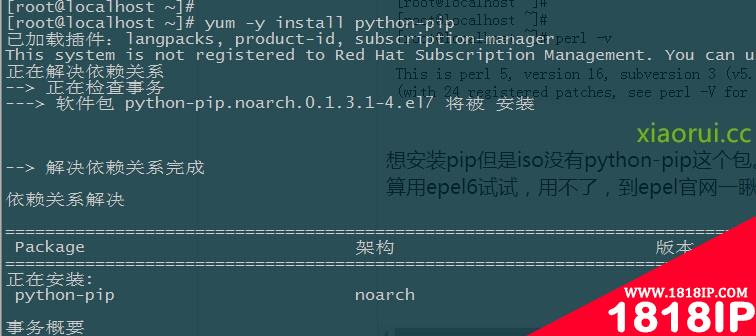半夜起来看世界杯,没啥激情,但是又怕错误意大利和英格兰的比赛,就看了RHEL 7相关新功能的介绍(RHEL 7的下载地址:https://access.redhat.com/site/downloads/ )。
安装还算顺利,安装的界面比以前简洁的多,很清爽,分类很是明确。
有些奇怪的是,我安装的时候,怕有些基础的包没有装上去,所以选定了mini和Web的类型,结果还是有些基础的包没有安装,比如 ifconfig 。虚拟机的网卡,被识别为ens,有意思。

yumgroupinstallBase
这样的话,就可以把一些基础的包打上。可以正常的时候ifconfig lsof 。
这里需要说明的是,redhat7的测试的repo源貌似不能用,我跟着地址看了下。压根就没有,我想应该还是测试版的原因吧。 直接mount /dev/cdrom /mnt用的。
[rhel-iso] name=RedHatEnterpriseLinux7 baseurl=file:///mnt/ enabled=1
系统的分区默认是xfs格式,当然你还是可以用ext3,ext4的:
[root@localhost~]#df-T 文件系统类型1K-blocks已用可用已用%挂载点 /dev/mapper/rhel-rootxfs3926220835913043567090410%/ devtmpfsdevtmpfs50077205007720%/dev tmpfstmpfs50750805075080%/dev/shm tmpfstmpfs50750826045049041%/run tmpfstmpfs50750805075080%/sys/fs/cgroup /dev/sda1xfs4949409544439949620%/boot
发现rhel7的开发软件版本不低。
python 是2.7.5的了,和ubuntu一样。 java默认也给你装上了。perl在centos6应该是5.10的 ,现在更新到了5.16.3 。 至于为什么更新到perl6,估计和python3一样吧。
[root@localhost~]# [root@localhost~]# [root@localhost~]#python-V Python2.7.5 [root@localhost~]#java-version javaversion"1.7.0_45" OpenJDKRuntimeEnvironment(rhel-2.4.3.4.el7-x86_64u45-b15) OpenJDK64-BitServerVM(build24.45-b08,mixedmode) [root@localhost~]# [root@localhost~]# [root@localhost~]#perl-v Thisisperl5,version16,subversion3(v5.16.3)builtforx86_64-linux-thread-multi (with24registeredpatches,seeperl-Vformoredetail)
想安装pip但是iso没有python-pip这个包。rhel7的官方源又打不开,郁闷。本来打算用epel6试试,用不了,到epel官网一瞅。epel居然已经有对于rhel7的源了。

简单测试下rhel7的openlmi,什么是openlmi,我看了下一些文档,他是一个类似func、但又不属于puppet这类的集群接口工具。
安装 yum install openlmi
安装 yum -y install openlmi-scripts*
scproot@10.10.10.71:/etc/Pegasus/client.pem/etc/pki/ca-trust/source/anchors/managed-machine-cert.pem [root@localhost~]#lmi-h10.10.10.71 lmi>hwinfo username:pegasus password: error:Failedtomakeaconnectionto"10.10.10.71":(0,'Socketerror:[Errno113]Noroutetohost') error:Nosuccessfulconnectionmade. lmi> lmi> lmi>
原因不详,我看了下官网对于openlmi的一些介绍,使用方面也是相当的简练。
lmi-h${hostname}
lmi>help
...
lmi>swsearchdjango
...
lmi>swinstallpython-django
...
lmi>exit
rhel7 用systemd替换了咱们熟悉的sysv ,说是这东西很强大,说实话,资料还是少,这里就简单讲解下systemd的用法。
#CentOS6.4 servicehttpd(start|stop) #rhel7 systemctl(start|stop)httpd.service #CentOS6.4 chkconfighttpd(on|off) #rhel7 systemctl(enable|disable)httpd.service $cat/usr/lib/systemd/system/httpd.service [Unit] Description=TheApacheHTTPServer After=network.targetremote-fs.targetnss-lookup.target [Service] Type=notify EnvironmentFile=/etc/sysconfig/httpd ExecStart=/usr/sbin/httpd$OPTIONS-DFOREGROUND ExecReload=/usr/sbin/httpd$OPTIONS-kgraceful ExecStop=/usr/sbin/httpd$OPTIONS-kgraceful-stop #Wewantsystemdtogivehttpdsometimetofinishgracefully,butstillwant #ittokillhttpdafterTimeoutStopSecifsomethingwentwrongduringthe #gracefulstop.Normally,SystemdsendsSIGTERMsignalrightafterthe #ExecStop,whichwouldkillhttpd.WearesendinguselessSIGCONTheretogive #httpdtimetofinish. KillSignal=SIGCONT PrivateTmp=true [Install] WantedBy=multi-user.target
会发现其实,用systemd参数更加的清晰,在sysv下,启动start、关闭stop、重启restart都是用$1来传递参数,但是在systemctl下,更直白点。很是像supervisord这个daemon程序。
[root@localhost~]#chkconfig--list|grepsamba 注意:该输出结果只显示SysV服务,并不包含原生systemd服务。SysV配置数据可能被原生systemd配置覆盖。 如果您想列出systemd服务,请执行'systemctllist-unit-files'。 欲查看对特定target启用的服务请执行 'systemctllist-dependencies[target]'。 [root@localhost~]# [root@localhost~]# [root@localhost~]#systemctllist-dependenciessamba samba.service [root@localhost~]#
数据库方面真的是转向到mariadb,当我去安装mysql的时候,他会直接去安装mariadb ,看来mariadb大势所趋呀。
[root@localhost~]#


